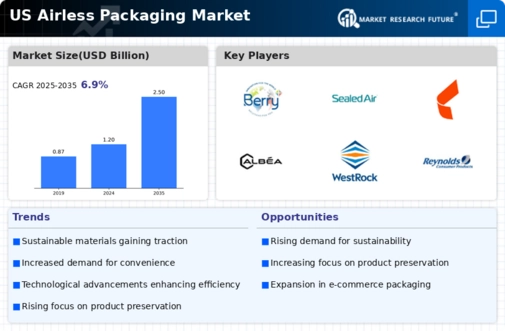Increased Regulatory Standards
The airless packaging market is significantly impacted by the rise in regulatory standards aimed at ensuring product safety and environmental sustainability. Regulatory bodies in the US are increasingly scrutinizing packaging materials and their impact on health and the environment. This has led to a growing emphasis on using materials that are not only safe for consumers but also environmentally friendly. The airless packaging market is adapting to these changes by developing compliant packaging solutions that meet stringent regulations. For instance, the use of recyclable and biodegradable materials is becoming more prevalent, aligning with regulatory expectations. As companies strive to comply with these standards, the airless packaging market is likely to witness an uptick in innovation and investment, ultimately enhancing product offerings and consumer trust.
Rising Demand for Premium Products
The airless packaging market experiences a notable surge in demand for premium products, particularly in the cosmetics and personal care sectors. Consumers increasingly seek high-quality formulations that promise enhanced efficacy and longevity. This trend is reflected in the market, where the value of airless packaging solutions is projected to reach approximately $1.5 billion by 2026. The airless packaging market benefits from this shift, as brands leverage innovative packaging to differentiate their offerings. The ability to preserve product integrity and extend shelf life resonates with consumers, driving their preference for airless solutions. As a result, manufacturers are investing in advanced materials and designs that cater to this premium segment, further propelling market growth. This demand for premium products is likely to continue influencing the airless packaging market, as brands strive to meet evolving consumer expectations.
Sustainability Initiatives by Brands
The airless packaging market is increasingly influenced by sustainability initiatives undertaken by brands across various sectors. Companies are recognizing the importance of adopting eco-friendly practices, which include the use of sustainable materials and reducing packaging waste. The airless packaging market is responding to this demand by developing solutions that align with sustainability goals. For instance, many manufacturers are exploring the use of recycled plastics and biodegradable materials in their airless packaging designs. This shift not only meets consumer expectations but also enhances brand reputation. Market analysis suggests that brands focusing on sustainability are likely to capture a larger share of the airless packaging market, as consumers are more inclined to support environmentally responsible companies. This trend is expected to drive innovation and growth within the industry, as brands seek to balance performance with environmental responsibility.
Technological Innovations in Packaging
Technological advancements play a crucial role in shaping the airless packaging market, as innovations in design and materials enhance product functionality. The introduction of new dispensing technologies, such as vacuum pumps and piston systems, allows for more efficient product delivery while minimizing waste. This is particularly relevant in sectors like skincare and pharmaceuticals, where precise dosing is essential. The airless packaging market is witnessing a shift towards smart packaging solutions that incorporate features like tamper-evidence and user-friendly designs. As brands increasingly adopt these technologies, the market is expected to grow at a CAGR of around 8% over the next five years. This growth is indicative of the industry's commitment to improving user experience and product performance through technological innovation.
Consumer Preference for Hygiene and Safety
The airless packaging market is experiencing a shift in consumer preferences towards hygiene and safety, particularly in the personal care and cosmetics sectors. As consumers become more health-conscious, they are increasingly drawn to packaging solutions that minimize contamination risks. Airless packaging offers a significant advantage in this regard, as it prevents air exposure and reduces the likelihood of product degradation. The airless packaging market is capitalizing on this trend by promoting the hygienic benefits of their products. This focus on safety is reflected in market data, which indicates that airless packaging solutions are gaining traction, with an estimated market share increase of 15% in the last year alone. As consumer awareness of hygiene continues to rise, the demand for airless packaging is likely to grow, further solidifying its position in the market.





















Leave a Comment